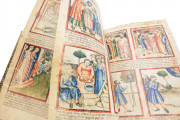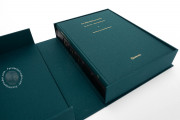The Paduan Bible Picture Book presents the stories of the Christian Bible's Old Testament books of Genesis, Exodus, Leviticus, Numbers, Deuteronomy, Joshua, and Ruth in miniatures that reflect contemporary trends in Italian wall painting. It was created in Padua around 1400, and most of its pages are dominated by illustrations in the form of framed miniatures, each depicting a moment in Old Testament history. Its two surviving portions boast 572 miniatures, of which five occupy a full page and most of which are arranged four—sometimes three—to a page.
The miniatures are in a style that resembles the appearance of contemporary fresco painting, with color washes of red, blue, green, and black and highlights in white. There is a convincing sense of volume in the rendering of the figures, which contributes to the illusion of a three-dimensional world in each miniature. Facial features, beards, and hair are drawn with great sensitivity.
Masters in the Tradition of Giotto
The artists, named the Masters of the Paduan Bible Picture Book for their work in this manuscript, also illuminated a set of choir books and two psalters. Their work is in the tradition—introduced by the early fourteenth-century master Giotto and continued in Padua in the work of Jacopo da Verona—of illusionistic narrative painting with spare but evocative landscape and architectural settings.
The World of the Ancient Israelites in Pictures
The manuscript presents a rich pictorial narrative of the lives of the patriarchs and the ancient Israelites. Some of the miniatures depict subjects, such as the Lord appearing to Moses in a burning bush (London, fol. 3r), familiar from earlier art, but most are without precedent.
The book of Genesis chronicles the lives of the patriarchs. Exodus records the wanderings of the Israelites, the events surrounding Moses's reception of the tablets of the law, and the construction of the ark of the covenant. Joshua features lively scenes of battle densely packed with figures in armor.
Focus on Holy Objects and the Priesthood
The five full-page miniatures are devoted to the ark of the covenant, the menorah, the establishment of the Jewish priesthood, and the tabernacle (London, fols. 16v, 17r, 17v, 21r, and 31r). The paintings of the sacred objects reflect many of the details of their long and sometimes enigmatic descriptions in the biblical text.
Inscriptions in the Local Dialect
The miniatures, the raison-d'être of the book, are accompanied by descriptions in Venetian-Paduan dialect. They are written in Gothic Rotunda above, between, and below the miniatures, often filling most of the page around the pictures. They are true descriptions of the pictures rather than paraphrases of the Bible. Individual figures in the miniatures are often identified by simple labels in Italian written in a less formal script.
At the end of Genesis, in empty frames for miniatures, there is a series of inscriptions in Hebrew and Aramaic (Rovigo, fol. 38v). The names of contemporary people are included, as is the beginning of a Hebrew alphabet.
A Book Divided
Portions of the picture book (Genesis and Ruth) are bound in a volume in the library of the Accademia dei Concordi in Rovigo, and the larger portion (Exodus through Joshua) is in a volume in the British Library. They were separated by the sixteenth century.
The Accademia library obtained its volume as a part of the private library of the Silvestri family through the donation in 1858 of Count Girolamo Silvestri (d. 1874) and Cardinal Pietro Silvestri (d. 1875). The British Library manuscript was owned by Augustus Frederick (1773-1843), Duke of Sussex, before being acquired by the British Museum in 1844. The manuscript was transferred to the British Library when it was established in 1973.
We have 1 facsimile edition of the manuscript "Paduan Bible Picture Book": Bilderbibel aus Padua facsimile edition, published by Quaternio Verlag Luzern, 2023
Request Info / Price






















